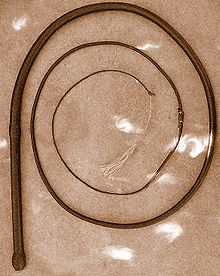
A nutcracker is a tool designed to open nuts by cracking their shells. There are many designs, including levers, screws, and ratchets. The lever version is also used for cracking lobster and crab shells.

Supersonic speed is the speed of an object that exceeds the speed of sound (Mach 1). For objects traveling in dry air of a temperature of 20 °C (68 °F) at sea level, this speed is approximately 343.2 m/s. Speeds greater than five times the speed of sound (Mach 5) are often referred to as hypersonic. Flights during which only some parts of the air surrounding an object, such as the ends of rotor blades, reach supersonic speeds are called transonic. This occurs typically somewhere between Mach 0.8 and Mach 1.2.

A sonic boom is a sound associated with shock waves created when an object travels through the air faster than the speed of sound. Sonic booms generate enormous amounts of sound energy, sounding similar to an explosion or a thunderclap to the human ear.

A braid is a complex structure or pattern formed by interlacing three or more strands of flexible material such as textile yarns, wire, or hair.

A whip is a tool or weapon designed to strike humans or animals to exert control through pain compliance or fear of pain. They can also be used without inflicting pain, for audiovisual cues, such as in equestrianism. They are generally either a firm stick designed for direct contact, or a flexible line requiring a specialized swing. The former is easier and more precise, the latter offers longer reach and greater force. A hunting whip combines a firm stick with a flexible line.

A lanyard is a length of cord, webbing, or strap that may serve any of various functions, which include a means of attachment, restraint, retrieval, activation, and deactivation. A lanyard is also a piece of rigging used to secure or lower objects aboard a ship.

The cat o' nine tails, commonly shortened to the cat, is a type of multi-tailed whip or flail. It originated as an implement for physical punishment, notably in the Royal Navy and British Army, and as a judicial punishment in Britain and some other countries.

A quirt is a short whip associated with the Southwestern United States. It often has a braided leather lash.

A crop, sometimes called a riding crop or hunting crop, is a short type of whip without a lash, used in horse riding, part of the family of tools known as Riding aids.

Florida crackers were colonial-era British, American pioneer settlers in what is now the U.S. state of Florida; the term is also applied to their descendants, to the present day, and their subculture among white Southerners. The first crackers arrived in 1763 after Spain traded Florida to Great Britain following the latter's victory over France in the Seven Years' War, though much of traditional Florida cracker folk culture dates to the 19th century.
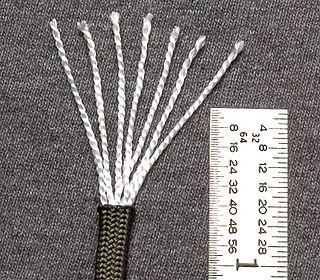
Parachute cord is a lightweight nylon kernmantle rope originally used in the suspension lines of parachutes. This cord is now used as a general purpose utility cord. This versatile cord was used by astronauts during the 82nd Space Shuttle mission to repair the Hubble Space Telescope.
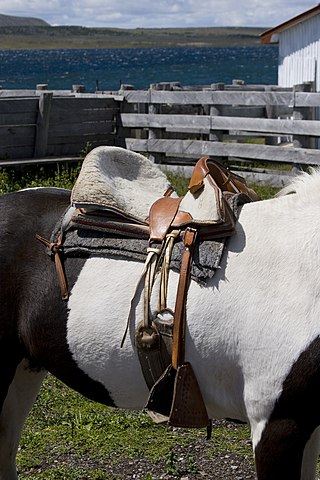
A girth, sometimes called a cinch, is a piece of equipment used to keep the saddle in place on a horse or other animal. It passes under the barrel of the equine, attached to the saddle on both sides by two or three leather straps called billets. Girths are used on Australian and English saddles, while western saddles and many pack saddles have a cinch, which is fastened to the saddle by a single wide leather strap on each side, called a latigo.

The Florida Cracker Horse is a critically endangered horse breed from the state of Florida in the United States. It is genetically and physically similar to many other Spanish-style horses, especially those from the Spanish Colonial horse group, including the Banker horse of North Carolina, and the Carolina Marsh Tacky of South Carolina.
Rebenque is the shared name in South American Spanish and Brazilian Portuguese for a type of whip used by gauchos in South America.
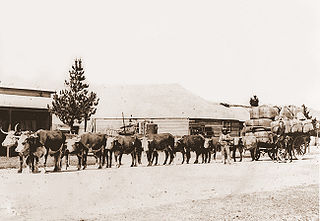
A bullocky is an Australian English term for the driver of a bullock team. The American term is bullwhacker. Bullock drivers were also known as teamsters or carriers.

Whipcracking is the act of producing a cracking sound through the use of a whip. Used during livestock driving and horse riding, it has also become an art. A rhythmic whipcracking belongs to the traditional culture among various Germanic peoples of Bavaria (Goaßlschnalzen), various Alpine areas (Aperschnalzen), Austria, and Hungary (Ostorozás). Today it is a performing art, a part of rodeo show in United States, a competitive sport in Australia and increasingly popular in the United Kingdom, where it crosses boundaries of sport, hobby and performance.

Donald Albert Hall was an American pioneering aeronautical engineer and aircraft designer who is most famous for having designed the Spirit of St. Louis.
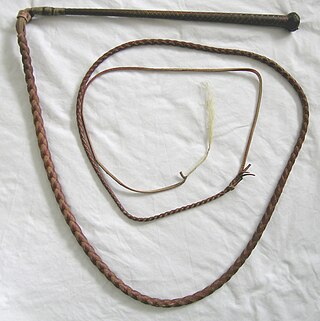
A stockwhip is a type of whip made of a long, tapered length of flexible, plaited leather or nylon with a stiff handle and thong able to pivot along the handle easily. Stock whips are used when mustering cattle.

A watch strap, watch band,watch bracelet or watch belt is a bracelet that straps a wrist watch onto the wrist. Watch straps may be made of leather, plastic, rubber, cloth, or metal, sometimes in combination. It can be regarded as a fashion item, serving both a utilitarian and decorative function. Some metal watch straps may be plated with, or even in rare cases made of, precious metals.

String is a long flexible structure made from fibers twisted together into a single strand, or from multiple such strands which are in turn twisted together. String is used to tie, bind, or hang other objects. It is also used as a material to make things, such as textiles, and in arts and crafts. String is a simple tool, and its use by humans is known to have been developed tens of thousands of years ago. In Mesoamerica, for example, string was invented some 20,000 to 30,000 years ago, and was made by twisting plant fibers together. String may also be a component in other tools, and in devices as diverse as weapons, musical instruments, and toys.
